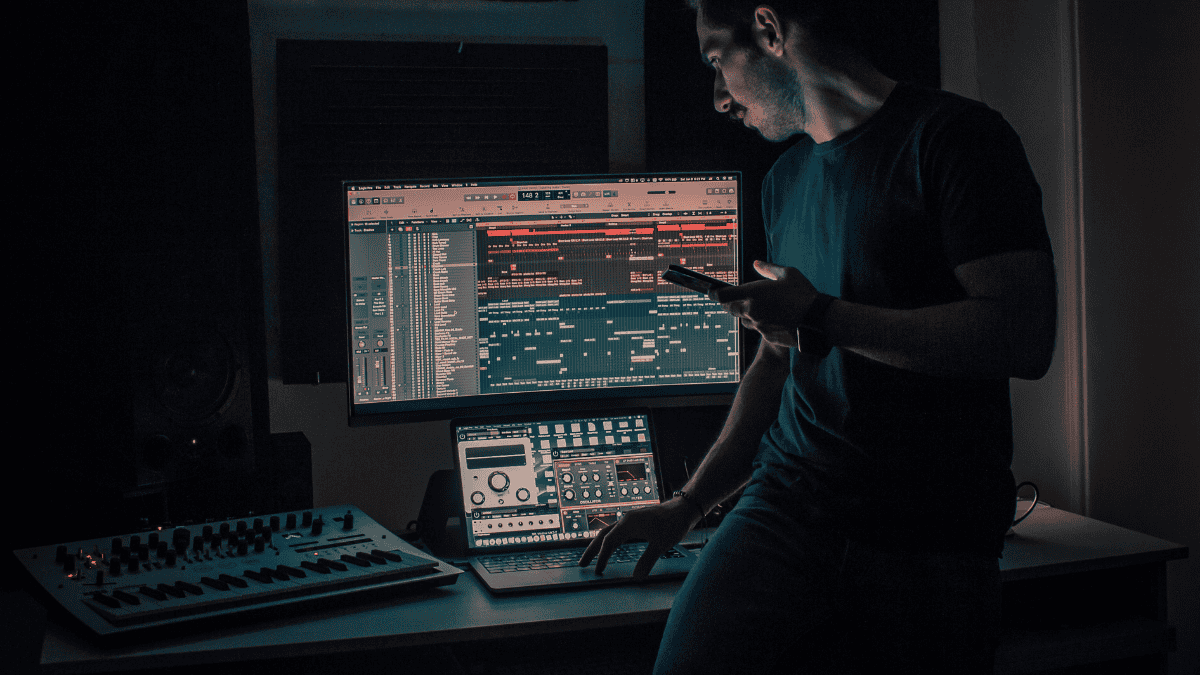Welcome to the Beginner’s Guide to Making Music on Your Computer! In this guide, we’ll start by answering a common question: What is a DAW?
Let’s dive in and explore the basics of music production software together.
Table of Contents
ToggleWhat is a DAW?
A DAW is short for digital audio workstation. It’s like a computer program for making music. You can use it to create, record, and mix all sorts of music, using different tools and instruments. People also use DAWs to make their music sound good.
How do DAWs work?
In many music programs, you can record on lots of tracks, letting you capture different sounds and mix them. You can record many sounds together or one by one.
You can use real instruments, computer sounds, or microphones to record. People often use computer sounds with something called MIDI, which is like digital music notes.
In these programs, you can make melodies and rhythms. You see all your sounds in a line, and you can change them however you want.
When you make music, you can adjust the sounds with different tools and effects. After you finish a song, you save it as one file. Before you share it, you make it sound even better with something called mastering.
People use small programs called plugins to help them make music. Plugins are tools you add to your music program to do different things, like make sounds or change them.
Are DAWs expensive?
Just like plugins, there are different prices for DAWs. Here are a few examples:
- Apple GarageBand: It’s free if you have a Mac or iPhone.
- Cockos REAPER: Costs between $60 and $225.
- Image Line FL Studio: Prices range from $99 to $899.
- Apple Logic Pro: costs $199.
- Ableton Live 12: It’s free to $749.
We also have a list of the best free DAWs if you want to save money.
If you’re ready to spend some money, we can also show you the main DAWs you can buy and their good and bad points.
Also, we have some advice on picking your first DAW so you can find the best one for you.
Other things you’ll need
Once you’ve got your music program, you might need a few more things. Here are some examples:
- A good computer
- Something to record your music with
- A microphone
- Wires to connect things
- A keyboard or controller
- Tools to change sounds (plugins)
- Good music and sounds
- Speakers
- Headphones
- Knowing a bit about music
- The basics you need are your computer, a recording tool, and speakers.
Many music programs already have effects and sounds. But you can get extra tools, some are free.
Here’s a list of the best free tools you can get today:
How to learn any DAW
Not every music program works the same, and different producers like different ways of working.
But, there are some tips you can use when you’re starting with any music program. Let’s go through them:
Explore the interface
Before diving into creating music, it’s useful to understand the layout of a DAW. Pay attention to how different windows like the timeline, mixer, and file browser are organized.
Also, make use of helpful tips that pop up when you hover over things, they can provide valuable information as you work.
Learn from the manual
Music software manuals have a lot of info, but you don’t need to read everything at once. Instead, pick what you want to learn more about and find it in the manual. It’s like having a guide to help you understand how different parts of the software work. Just find the sections that explain what you’re curious about, and learn from them.
Learn from an example project
To understand how a DAW works, look at a sample project.
Most DAWs have sample projects included, or you can find free ones online.
Choose a project with a full song and listen to it.
While listening, check out each track to see how they’re made and what effects are used.
Experiment with the effects and mixer settings to learn about making a mix, or change the song’s structure to see how the timeline works.
Go one step at a time
Music production software like DAWs can seem complicated, but don’t let that discourage you.
Choose one thing to learn at a time, like using an EQ or making a melody.
Once you feel good about that, try learning something else, like creating song transitions.
Get Better at Listening
Content: Knowing how to listen is super important, maybe even more than knowing how to use your tools.
Find a project you really like, one that’s similar to what you want to make.
Listen carefully and ask yourself, “Why does this sound good?” Understanding why the parts work together helps you learn the technical stuff better.
Explore Music-Making Help Online
Content: It’s a good time to learn about making music.
There are many great resources online for popular music software.
Just like with your DAW’s manual, you can search YouTube for what you want to learn.
We have beginner guides for different music software like Ableton Live, Logic Pro, Reaper, Pro Tools, and FL Studio.
You can also find courses from experts to start using a DAW.
Take Your Time with Music Making
Content: Making an amazing track right away might be something you really want (and you might be really good), but learning a DAW takes time.
Don’t worry if parts of the software are confusing or if your first songs don’t sound just how you want.
Keep learning, stay excited, and give yourself room to get better.
Remember, the DAW is just a tool—you bring the creativity and skill to make awesome music.




